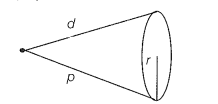Consider a 20 W bulb emitting light of wavelength 5000 and shining on a metal surface kept at a distance of 2 m. Assume that the metal surface has a work function of 2 eV and that each atom on the metal surface can be treated as a circular disk of radius 1.5 .
(i) Estimate the number of photons emitted by the bulb per second.
[Assume no other losses}
(ii) Will there be photoelectric emission?
(iii) How much time would be required by the atomic disk to receive energy equal to work function (2 eV)?
(iv) How many photons would the atomic disk receive within the time duration calculated in (iii) above?
(v) Can you explain how the photoelectric effect was observed instantaneously?
Hint: The no. of photons emitting from a surface depends on the intensity of radiation.
Step 1: Find the no. of photons emitted by the bulb per second.
Given,
(i) Number of photons emitted by bulb per second is;
Step 2: Find the energy of incident photons.
(ii) Energy of the incident photon,
As this energy is greater than 2 eV (i.e., work of metal surface), hence photoelectric emission takes place.

Step 3: Find the time of getting energy.
(iii) Let t be the time spent in getting the energy, =work function of the metal.
Consider the figure,
Step 4: Find the no. of photon received in t.
(iv) Number of photons received by the atomic disc in time t is:
(v) As the time of emission of electrons is 11.04 is s.
Hence, the photoelectric emission is not instantaneous in this problem.
ln photoelectric emission, there is a collision between the incident photon and free electron of the metal surface, which lasts for a very-very short interval of time , hence we say photoelectric emission is instantaneous.

© 2025 GoodEd Technologies Pvt. Ltd.